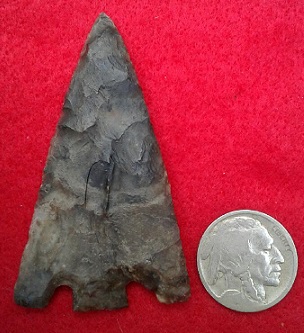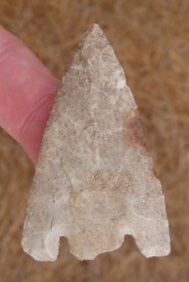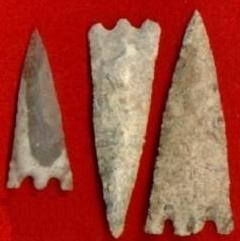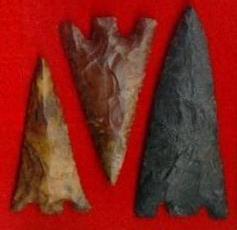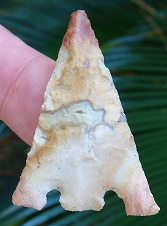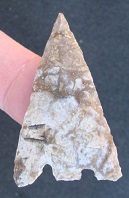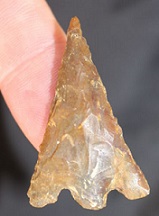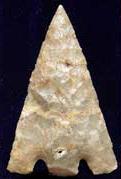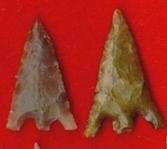Outline is Representative of Size and Shape:
 Sub-Type
III
Sub-Type
III
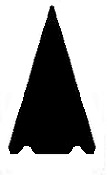 Sub-Type
II
Sub-Type
II
 Sub-Type
I
Sub-Type
I
 Sub-Type
III
Sub-Type
III Sub-Type
II
Sub-Type
II Name Details:
Identified By: Ripley P. Bullen
Named For: Hernando County, Florida
Date Identified: 1968
Type Site:
Identified By: Ripley P. Bullen
Named For: Hernando County, Florida
Date Identified: 1968
Type Site:
Point Validity:
Valid type
Bullen was a distinguished anthropologist and Curator Emeritus of the Florida Museum of Natural History. He was dedicated to identifying and typing projectile points from Florida. This point was named in a professional publication and is professionally a widely recognized type. This is a valid type.
Hernando Basal Notch
Edited by William LunsfordCluster:
Description of Physical Characteristics and Flaking Pattern:
This is a thin small to medium (1.5 to 2.5 inches) triangular basal notch point with a flattened to elliptical cross section. The blade is primarily straight, but may vary to excurvate. Rarely (less thank 15%) the blade will have serrations. The shoulders are barbed and extend to the base of the point. Short U or V shaped notches enter the base of the point. The stem varies from straight to contracting. The base may range from straight to pointed. This point has a random flaking pattern and is usually well made.
Size Measurements:
Total Length - 26 to 63 mm (average 35 to 48 mm), Stem Length - 3 to 7 mm (average 4 to 5 mm), Width - 18 to 40 mm (average 25to 35 mm), Stem Width - 3 to 13 mm (type 1 typically 3 to 7 mm and type 2 typically 7 to 13 mm), Thickness - 5 to 9 mm
Total Length - 26 to 63 mm (average 35 to 48 mm), Stem Length - 3 to 7 mm (average 4 to 5 mm), Width - 18 to 40 mm (average 25to 35 mm), Stem Width - 3 to 13 mm (type 1 typically 3 to 7 mm and type 2 typically 7 to 13 mm), Thickness - 5 to 9 mm
Commonly Utilized Material:
Additional Comments:
The difference between the Citrus point and the Hernando point can be confusion. It has been argued that they represent the same point at different ends of the spectrum. Others have argued that they are separate types. They are found in the same general distribution and has many of the same characteristics. They are commonly found at the same sites at the same levels. It may be that the two types may be variants of each other. The Citrus type has a larger wider stem with deeper notches than the Hernando type has (Granger and Granger, 2013). Another key difference is that the Citrus point has a convex basal edge (from tip of barb to tip of barb forms a circular pattern) with an excurvate blade with rounded edges on the outer barbs (W18). Hernando points have a straighter blade with barbs that are squarer and a straight basal edge (from barb to barb) than the Citrus type. The Citrus is also generally a little large than the Citrus and it has been suggested that the Citrus is the knife form of the Hernando point (Bullen, 1975).
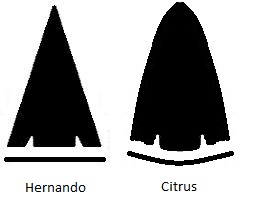
The difference between the Citrus point and the Hernando point can be confusion. It has been argued that they represent the same point at different ends of the spectrum. Others have argued that they are separate types. They are found in the same general distribution and has many of the same characteristics. They are commonly found at the same sites at the same levels. It may be that the two types may be variants of each other. The Citrus type has a larger wider stem with deeper notches than the Hernando type has (Granger and Granger, 2013). Another key difference is that the Citrus point has a convex basal edge (from tip of barb to tip of barb forms a circular pattern) with an excurvate blade with rounded edges on the outer barbs (W18). Hernando points have a straighter blade with barbs that are squarer and a straight basal edge (from barb to barb) than the Citrus type. The Citrus is also generally a little large than the Citrus and it has been suggested that the Citrus is the knife form of the Hernando point (Bullen, 1975).
Bullen (1975) states that the primary difference between the Hernando and Citrus if the "Basally curved tang" or "rocker" base

Distribution: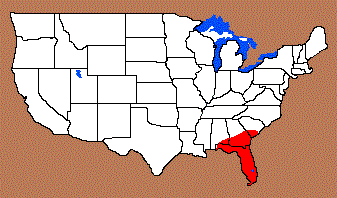
Distribution Comments:
This point is primarily found in Florida and into southern Georgia and southern Alabama. This point has rarely been reported into central Georgia and southwestern South Carolina.
This point is primarily found in Florida and into southern Georgia and southern Alabama. This point has rarely been reported into central Georgia and southwestern South Carolina.
Age / Periods:
Date: 2,400 - 1,600 B.P.
Cultural Period: Early to Middle Woodland
Glacial Period: Roman Warm
Culture:
Date: 2,400 - 1,600 B.P.
Cultural Period: Early to Middle Woodland
Glacial Period: Roman Warm
Culture:
Age Details:
Whatley (2002), notes Hernando points appear to be associated with Refuge and Deptford ceramics in southern Georgia .
Bullen (1975) feels that associations with the Perico Island, Deptford, Swift Creek, Belle Glade IA, and St. Johns periods suggest a date of 500 B.C. to 200 A.D.
Whatley (2002), notes Hernando points appear to be associated with Refuge and Deptford ceramics in southern Georgia .
Bullen (1975) feels that associations with the Perico Island, Deptford, Swift Creek, Belle Glade IA, and St. Johns periods suggest a date of 500 B.C. to 200 A.D.
Other points in this cluster / Related / Associated Points:
Citrus
Citrus

